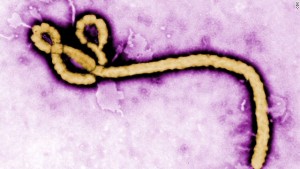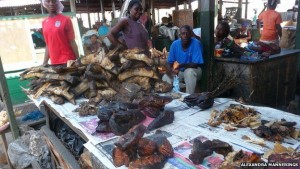In developed countries the threat of contracting Ebola from food sources is null, but in areas of Africa it is a real threat. Throughout late 2014 and early 2015, Ebola was widely publicized as the virus moved from Africa to the United States although Ebola has been a constant problem in Africa for years.
Ebola is a virus that is generally spread by direct contact with body fluids or blood of an infected person, but in Africa it may also be spread while consuming, hunting or preparing Bushmeat. Bushmeat is an umbrella term that groups together meat from wild animals such as bats, antelope, rats, monkeys and other nonhuman primates.The main reservoir of the virus appears to be fruit bats. It is either through the consumption of fruit bats, or cross contamination between fruit bat droppings and other bushmeat animals that causes Ebola to be transmitted through food.
Bushmeats are main sources of food for some and often seen a treat for others at markets and roadside stands. These types of meats are usually dried, salted or smoked in the open African heat alongside other butchered animals. This is a breeding ground for other bacteria and cross contamination can easily occur with other bacteria of concern such as E. Coli and Salmonella. The consequences of Ebola are high, one strain tied back to fruit bats in the Congo area found that 40% of infected patients died. Ebola causes hemorrhagic fever, headaches and can result in death.
Ebola can be destroyed by heating to 60 degree Celsius for 60 minutes or at higher temperatures of 72-80 degrees Celsius for 30 minutes according to the CDC. While heating Ebola has been found to inactivate and destroy the virus there is still the issue of cross contamination, as seen in the following picture the spaces used to cook and prepare the meat appear unhygienic and less than ideal. It is also difficult to know if the meats have been cooked to the proper temperatures as most would not have access to thermometers. The ones that are at highest risk of contracting the virus from animals are those who are hunting and gathering these animals as many are bitten or scratched or come in contact with blood during these processes.
The likelihood of contracting the disease from human contact is much higher than from bushmeats. Hundreds of thousands of varying types of bushmeat are consumed annually throughout Africa and this will likely continue as it is a source of nutrition and part of their culture. It is recommended that steps be taken while hunting and gathering to reduce infection such as avoiding blood and fluids from animals, wearing gloves, not consuming predeceased animals and keeping raw foods away from cooked. These steps will not eradicate all cases of Ebola in Africa but it may help decrease the amount of outbreaks.
If you would like to learn more please watch the video below.
References:
DRC: Bushmeat blamed for Ebola outbreak. (2012, August 23). Retrieved November 11, 2015, from http://www.irinnews.org/report/96160/drc-bushmeat-blamed-for-ebola-outbreak
Hogenboom, M. (2014, October 19). Ebola: Is bushmeat behind the outbreak? – BBC News. Retrieved November 11, 2015, from http://www.bbc.com/news/health-29604204
Information on the Survivability of the Ebola Virus in Medical Waste. (2015, February 12). Retrieved November 11, 2015, from http://www.cdc.gov/vhf/ebola/healthcare-us/cleaning/ebola-virus-survivability.html
MacNeil, A. (2010, December 1). Proportion of Deaths and Clinical Features in Bundibugyo Ebola Virus Infection, Uganda – Volume 16, Number 12-December 2010 – Emerging Infectious Disease journal – CDC. Retrieved November 11, 2015, from http://wwwnc.cdc.gov/eid/article/16/12/10-0627_article


